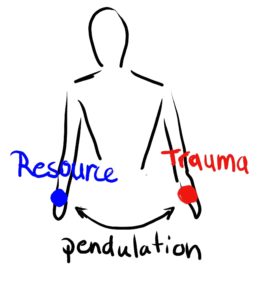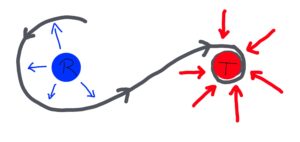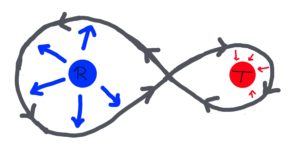Pendulation is an essential body work tool that can be useful in many areas of trauma treatment. It describes the inner motion of our attention and awareness, moving back and forth between a resource/resourceful place and something trauma-related/ a place that is low in resources. The goal is to dissolve states that are stuck, bring some movement into our nervous system and achieve regulation.
 What is a resource or a resourceful place?
Resources are all the things that move our body toward regulation and calm, that help us to relax, to feel safe or connected with loved ones, things that are beautiful, make us feel good or remember good moments. If none of this is available, anything that is neutral will do. Some examples for different kinds of resources:
What is a resource or a resourceful place?
Resources are all the things that move our body toward regulation and calm, that help us to relax, to feel safe or connected with loved ones, things that are beautiful, make us feel good or remember good moments. If none of this is available, anything that is neutral will do. Some examples for different kinds of resources:
-
a body part that feels warm/relaxed/good or at least neutral or a bit better than others -
a safe person in the room with us -
thinking of a loved one or a pet, maybe something to remind us of them -
encouraging items like painted stones, photos, bracelets, stuffies,.... -
the physical memory of feeling strong/relaxed/powerful/grounded (body anchors) -
thoughts of safe encounters or group experiences of connection -
looking at a plant or outside the window -
favorite body sensations (like warmth or wind) -
memories of feeling awe -
…. -
….
Our therapists will help us to develop our resources, become more aware of them and expand on the positive (physical) feelings to shape them into something that we can intentionally use to help ourselves in therapy situations or at home. EMDR uses resource installation, body work therapists help to create body anchors, hypnotherapists can use trances to expand on positive memories etc.
Resource deserts
On the other side of our pendulum we have the trauma-related things. They feel stuck, terrifying, bad; all the despair, dysregulation, trauma memories, the things that suck us in and keep us prisoner are on this side. It feels like the world gets very small here and resources are nowhere to be seen. Some examples are
-
flashbacks -
body flashbacks -
trauma-related vehement emotions -
flight/fight, freeze or shutdown responses -
trauma scenes we work on in therapy -
crises that happen in our life today -
stress -
triggering situations (like medical exams etc) -
…. -
….
Whenever we experience a resource desert, we can mindfully identify the trauma-related side: the picture, feeling, body sensation or whatever it is that is tormenting us. Then we pick something from the resources we developed. Next we take our mindful awareness and slowly move it back and forth between the two. It takes practice. At first it can be very hard to take the attention away from the pain and turn it toward something else. We practice guiding our awareness with meditation that is focused on just that. After a while the trauma desert will slowly release us and our body regulates itself again.
When we first start practicing pendulation it can be hard to even remember our resources. Our world shrinks into this tight knot of pain and suffering. It takes practice to remember pendulation and make use of it.
 After a while it can get easier to experience low-resource places. They won't go away, but they won't suck us in so forcefully either and it gets easier to return to our resources and regulate. Trauma-related things cause some stress, but we won't get stuck there. We are building up resilience, our ability to return to regulation after getting stressed. More
After a while it can get easier to experience low-resource places. They won't go away, but they won't suck us in so forcefully either and it gets easier to return to our resources and regulate. Trauma-related things cause some stress, but we won't get stuck there. We are building up resilience, our ability to return to regulation after getting stressed. More
 What pendulation can look like
Emotions
When we feel stuck in trauma-related vehement emotion like toxic shame we can mindfully sense what that feels like, then think of e.g. a time when we felt connected with friends, as best we can. Then we sense our shame again for a moment, mindfully noticing any differences to what it felt like before, and return to the memory with friends. It takes a while, but over time we can notice how the shame changes and we start to get more grounded. This can be done with any emotion.
We could also use our posture to oscillate out of a stuck emotion. For that we can notice the posture we naturally took as an expression of our emotion. Then we change the posture into one that reminds us of feeling powerful or safe. After mindfully noticing how that feels we return to our initial pose, sense how it feels and any changes that might have happened, and repeat this a couple of times.
Stress responses
When we are in flight/fight it is best to find a safe release for all the energy soaring through our body. We can follow our motor impulses, the movements we would like to do, like running in place or pretending to slap someone in the face or verbalize things. Then we mindfully sense how we feel and repeat as needed. We use pendulation in combination with titration here if a release is still too difficult and we can't contain it in our window of tolerance, in other words, if it would overwhelm us or cause dissociation if we tried. Let your T help you with this, it is tricky to learn and you likely need help first.
When we are in freeze or shutdown, we can use small movements or even just the imagery or memory of movement to get unstuck. We explained in detail how to get out of freeze. With mild dissociation we can take turns feeling our sensations of numbness or disconnection and then turn toward small movement, warmth or relational resources. They are usually the most effective. Slowly oscillating our way out of the dissociation is more gentle than the use of DBT skills and avoids unnecessary stress while grounding.
If we are chronically dysregulated, relaxation doesn't feel safe or physical stillness is triggering, we can use pendulation to get in touch with these new experiences and find safety there, too. More
Somatic flashbacks
Some people feel pain or other trauma-related things in their bodies. It is best to pick a body part that feels safe or warm or at least neutral and then move awareness between that and the parts that feel unwell. It is uncomfortable but also one of the most effective ways to end body flashbacks. We have written about it in detail here.
Stressful or triggering situations
We get into stressful situations. It cannot always be avoided. But we can manage them a lot better if we use pendulation while we are in them. We could look around and find something that looks nice like a tree or a pretty picture. While we stay present with what is happening we can move our attention to the resource every now and then to give ourselves a little break. It keeps the nervous system active and regulating so the experience won't get stuck and add to the stress we already carry. That builds a ton of resilience!
Trauma processing
Processing is always done with the help of a therapist. It is extremely tricky work and even if we know how it is done theoretically we can't properly do it on ourselves, so don't try.
It is still worth knowing that all effective trauma processing has an element of pendulation. We are guided to remember some of the things that happened, then get a break to regulate and focus on resources, before going back to the memory. It helps our body to release survival energy that is stuck while our brain processes things too.
It doesn't matter if you are having TF-CBT or EMDR or Somatic Experiencing, with complex trauma they should all work with a combination of titration and pendulation. EMDR has it built into the technique, since intervals of exposure are followed by moments of re-orientation and re-connecting with resources. There are variations in how TF-CBT is done and you should tell your therapist to pay special attention to giving you the breaks to get in touch with resources. Not everyone is aware how important they are for processing to work.
Generally, when things feel overwhelming, cause dysregulation or don't seem to work at all, I turn toward titration.
When I feel stuck with something the answer is usually pendulation. Often both are needed.
Pendulation gently reduces the effects of trauma on our everyday life and nudges our body to regulate. It is an effective way to build resilience and increase our window of tolerance. Combined with special techniques it is a key to processing the past.
What pendulation can look like
Emotions
When we feel stuck in trauma-related vehement emotion like toxic shame we can mindfully sense what that feels like, then think of e.g. a time when we felt connected with friends, as best we can. Then we sense our shame again for a moment, mindfully noticing any differences to what it felt like before, and return to the memory with friends. It takes a while, but over time we can notice how the shame changes and we start to get more grounded. This can be done with any emotion.
We could also use our posture to oscillate out of a stuck emotion. For that we can notice the posture we naturally took as an expression of our emotion. Then we change the posture into one that reminds us of feeling powerful or safe. After mindfully noticing how that feels we return to our initial pose, sense how it feels and any changes that might have happened, and repeat this a couple of times.
Stress responses
When we are in flight/fight it is best to find a safe release for all the energy soaring through our body. We can follow our motor impulses, the movements we would like to do, like running in place or pretending to slap someone in the face or verbalize things. Then we mindfully sense how we feel and repeat as needed. We use pendulation in combination with titration here if a release is still too difficult and we can't contain it in our window of tolerance, in other words, if it would overwhelm us or cause dissociation if we tried. Let your T help you with this, it is tricky to learn and you likely need help first.
When we are in freeze or shutdown, we can use small movements or even just the imagery or memory of movement to get unstuck. We explained in detail how to get out of freeze. With mild dissociation we can take turns feeling our sensations of numbness or disconnection and then turn toward small movement, warmth or relational resources. They are usually the most effective. Slowly oscillating our way out of the dissociation is more gentle than the use of DBT skills and avoids unnecessary stress while grounding.
If we are chronically dysregulated, relaxation doesn't feel safe or physical stillness is triggering, we can use pendulation to get in touch with these new experiences and find safety there, too. More
Somatic flashbacks
Some people feel pain or other trauma-related things in their bodies. It is best to pick a body part that feels safe or warm or at least neutral and then move awareness between that and the parts that feel unwell. It is uncomfortable but also one of the most effective ways to end body flashbacks. We have written about it in detail here.
Stressful or triggering situations
We get into stressful situations. It cannot always be avoided. But we can manage them a lot better if we use pendulation while we are in them. We could look around and find something that looks nice like a tree or a pretty picture. While we stay present with what is happening we can move our attention to the resource every now and then to give ourselves a little break. It keeps the nervous system active and regulating so the experience won't get stuck and add to the stress we already carry. That builds a ton of resilience!
Trauma processing
Processing is always done with the help of a therapist. It is extremely tricky work and even if we know how it is done theoretically we can't properly do it on ourselves, so don't try.
It is still worth knowing that all effective trauma processing has an element of pendulation. We are guided to remember some of the things that happened, then get a break to regulate and focus on resources, before going back to the memory. It helps our body to release survival energy that is stuck while our brain processes things too.
It doesn't matter if you are having TF-CBT or EMDR or Somatic Experiencing, with complex trauma they should all work with a combination of titration and pendulation. EMDR has it built into the technique, since intervals of exposure are followed by moments of re-orientation and re-connecting with resources. There are variations in how TF-CBT is done and you should tell your therapist to pay special attention to giving you the breaks to get in touch with resources. Not everyone is aware how important they are for processing to work.
Generally, when things feel overwhelming, cause dysregulation or don't seem to work at all, I turn toward titration.
When I feel stuck with something the answer is usually pendulation. Often both are needed.
Pendulation gently reduces the effects of trauma on our everyday life and nudges our body to regulate. It is an effective way to build resilience and increase our window of tolerance. Combined with special techniques it is a key to processing the past.

Leave a Reply